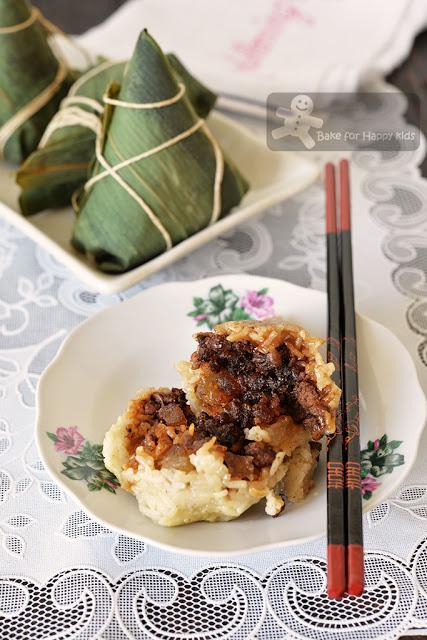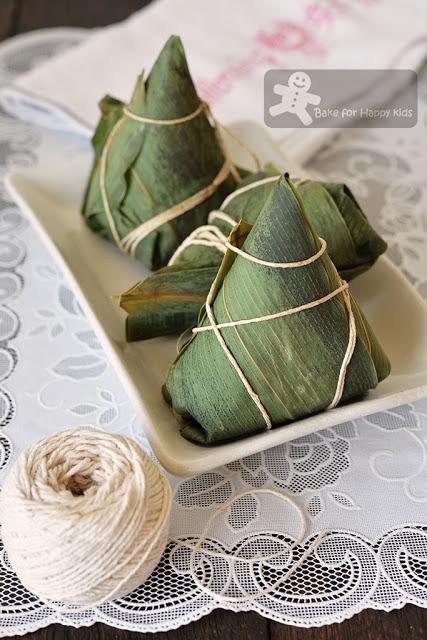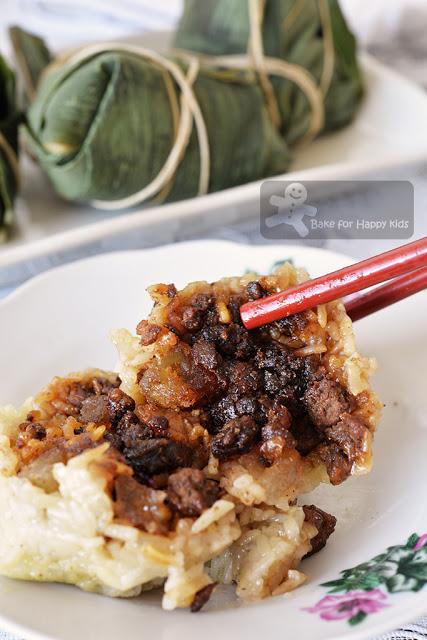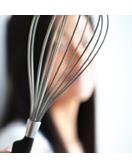Ai yo! Nyonya chang AGAIN!!!
I'm sorry that I have to cook another version of nyonya Glutinous rice dumplings because I know my meat-loving husband and child will surely complain if I serve them meatless mushroom Nyonya glutinous rice dumplings at here. And so, I have to make another batch of Nyonya chang with meat.
Then why chicken nyonya chang? Not pork? Traditionally, nyonya chang are made with pork belly or shoulder and these meat are typically so much more higher in their fat content comparing to most generic skinless chicken mince.
Although I have to totally admit that the fatty pork belly will make the moistest bak chang filling, the health conscious side of me tells me that I must give chicken mince a go!
So let's see if it is acceptable to use skinless chicken mince to make delicious nyonya chang.

Chicken Nyonya Glutinous Rice Dumpling Bak Chang
Not bad, huh?
Can we use skinless chicken mince to make delicious nyonya chang?
It's a YES from me.
YES from my Aussie-born son who adore almost all Singapore local food except durian!
YES from my fussy husband.
YES that this chicken nyonya chang is awesome with acceptable amount of X factor!!! LOL!
And I wonder if you will say YES too?
Like my vegetarian mushroom Nyonya chang at here, I reckon the key thing to make the Nyonya chang tastes really authentic is actually the spices, pandan leaves, winter melon and shallot crisps. With these essential aromatic ingredients, I guess that the choice of the meat to use or even making the filling meatless is sort of "not so important" resulting the absence of the fatty pork belly to be easily concealed.
Obviously, these chicken bak chang are not going to be as moist as those that are made with pork belly but if you seriously consider the pros and cons plus give and take this bak chang situation, I won't be surprised that you will think that these chicken dumplings are acceptably delicious too!
So why not give this chicken nyonya bak chang a go if you are health-conscious like me or prefer not to eat pork for some reasons?

My nyonya chang... Made with No pork but with chicken!

Not bad, huh?
I must say that these chicken nyonya chang tastes really like the authentic nyonya chang!
... but minus the fat and calories :p
Here's my video showing how I made these chicken nyonya chang.
Please pardon me for being so naggy... but I do have these same-old-thing but totally essential points to mention...
1) Like my previous nyonya chang at here, I'm using basmati rice and glutinous rice in 1:1 ratio to make these dumplings too so that we can enjoy our glutinous rice that is sticky enough and yummy and won't give us any indigestion problem! However, the use of mixture of rice is totally optional and it is really up to you if you prefer to use a mixture of basmati rice and glutinous rice or not.
2) If you choose to use a mixture of glutinous rice and basmati rice to cook your dumplings, please do not keep the dumplings in the freezer because cooked basmati rice don't freeze very well. However, if you die die must freeze your dumplings, the best thing to do is to make your dumplings with glutinous rice and NO basmati rice and you can keep your cooked dumplings in a freezer up to a month.
3) Traditionally, the rice of nyonya chang should be partially coloured with blue pea flower extract. Unfortunately, blue pea flowers are not easily available in Melbourne especially winter! Due to this reason, we prefer not to color our nyonya chang rice with any artificial blue color.
4) I must admit that I'm not a ba chang expert and don't make ba chang very often. All that I know is from observing my grandma when I was younger than ten. So please pardon me for being so kiasu (meaning afraid to lose in Singlish) tying all angles of my dumplings! Paiseh lah... (meaning bashful in Singlish and Hokkien language)
Here's the recipe for my small family.
You can double or triple this amount if you wish to make more dumplings.Make 12 medium dumplings
For the rice:
300g long grain glutinous rice, washed300g long grain basmati rice, washed - you can replace this rice with all glutinous rice if you prefer the traditional all sticky ba chang.
blue colouring from blue pea flower water* or blue food colouring to color the rice, optional
*To extract blue pea flower water. Use mortar and pestle to pound about 15-16 washed and dried flowers with 2 tbsp water. Squeeze the juice from the macerated flower as much as possible. Unfortunately, blue pea flowers are not easily available in Melbourne and we prefer not to color our rice with artificial colouring.
To color the rice, sprinkle blue pea flower water or a few drop blue food colouring onto 1/5 of the thoroughly drained glutinous rice.
To season the rice:
1 tsp shallot oil - see below **1 tsp five-spice powder
1/2 tsp caster sugar
1/2 tsp ground white pepper
1 tsp salt
Soak glutinous rice in water for at least 2 hrs at room temperature, then drained thoroughly. Tip: To preserve the fragrance of the rice, I have seen many recipes that say NOT to soak glutinous rice for dumpling overnight and so I did exactly what I was told.
While the rice is soaking, you can prepare the rest of the ingredients, combine seasonings for the rice and the filling and cook the filling.
For the filling:
A:5 shallots, peeled, finely sliced
adequate cooking oil to deep fry shallots until golden brown and crispy
B:
1 tbsp cornflour300g skinless chicken mince
2 tbsp shallot oil - see below **
2 tbsp shallot mince
2 tsp garlic mince
5 dried shiitake mushroom, soaked in hot boiling water to soften, squeezed to remove any excess water and cut into 2 cm pieces
100g candied winter melon, coarsely chopped
To season the filling:
1 tsp seasme oil1 tsp five-spice powder
2 tbsp coriander powder
1 tbsp light soy sauce
1 tbsp dark soy sauce
1 tbsp caster sugar
1/2 tsp ground white pepper
1/4 tsp salt
For wrapping:
24 dried bamboo leaves or more if required, soaked until soft, cleaned with water - I used the vaccum packed kind and so I don't have to soak mine in water.pandan leaves, cut into ten 3 cm small rectangle pieces
cooking twine or any heat resistance strings
To cook the filling:
A:
Fry sliced shallot in adequate cooking oil until golden and crispy and drain off any excess from the shallot crisps by placing them on a paper towel. Reserve the shallot (or ginger) oil ** for subsequent cooking and seasoning.B:
Add cornflour into chicken mince and mix until combined. Set aside.Heat shallot oil with high heat in a wok and sauté shallot and garlic mince for 1-2 mins or until fragrant. Add chicken and cook and break chicken mince into small pieces for about 2-3 min or until golden brown. Add mushroom and and fry briefly for about 1-2 min or until fragrant. Combine and add filling seasoning. Cook and stir for 2-3 mins until all are well coated with the seasonings. Remove from heat and stir in winter melon and shallot crisps.
To wrap and cook the dumplings:
Take 2 bamboo leaves and overlap them together and fold in the middle to form a cone.Place 1-2 tbsp glutinous rice (plus 1/2 tbsp coloured rice) into the cone. Use a spoon to press rice in the middle to pack it tightly and at the same time, form a little depression in the middle. Fill the depression with 2 tbsp filling. Then top with another 1-2 tbsp glutinous rice (plus 1/2 tbsp coloured rice). Add a piece of pandan leaf on the rice and fold the bamboo leaf down to cover the rice and wrap the excess leaf around to form a 3D triangular shape.
Use cooking twine or strings to tie the dumpling in its middle to secure the shape of the dumpling but not too loose so that the dumpling won't break apart and not too tight as it will prevent the dumpling from swelling during cooking. Difficult? I must admit that it took me a while to get use to tying my dumplings. I must admit too that I have been kiasu tying all angles of my dumplings! Repeat this wrapping step to wrap and tie the rest of the dumplings.
Boil dumplings in a large pot of water for about 1 1/2 hrs or cook in a pressure cooker with high pressure for about 30-40 mins or until the dumplings are thoroughly cooked. If you are using a pressure cooker to cook your dumpling, it is recommended to leave the dumpling to de-pressurize slightly in the cooker for about 15 mins when the cooker is switched off.
Remove dumplings from hot water and place them on a rack or hang them up to drip dry. Serve and enjoy.
If you use a mixture of glutinous rice and basmati rice to cook your dumplings, please do not keep the dumplings in the freezer. If your dumplings are made with glutinous rice with NO basmati rice, you can keep your dumplings in a freezer up to a month. To defrost, steam or microwave dumplings until they are thoroughly warm.
Happy CookingPlease support me and like me at Facebook...

